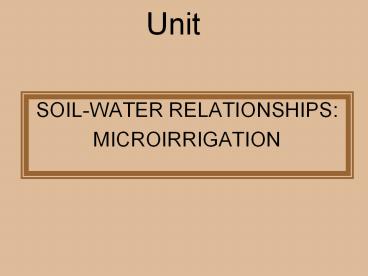SOIL-WATER RELATIONSHIPS: - PowerPoint PPT Presentation
Title:
SOIL-WATER RELATIONSHIPS:
Description:
Unit SOIL-WATER RELATIONSHIPS: MICROIRRIGATION How do rates/ affect patterns Soils with large pore spaces have less of a capillary flow, upward and lateral flow ... – PowerPoint PPT presentation
Number of Views:871
Avg rating:3.0/5.0
Title: SOIL-WATER RELATIONSHIPS:
1
Unit
- SOIL-WATER RELATIONSHIPS
- MICROIRRIGATION
2
Learning Objectives
1. Define infiltration, application rate, and
wetted pattern.
2. Describe the relationships between soil
texture, infiltration rates, and wetted pattern.
3. Analyze a specific site for inputs into design
and management of a microirrigation system.
3
Terms
Application rate Capillary flow Emitter
Infiltration Tensiometer Wetted pattern
4
What are infiltration, application rate and
wetted pattern?
Irrigation success is founded on many basic
principles.
- Infiltration is the process by which water
moves into the soil.
5
Infiltration, Rates, Patterns
- Application rate is the amount of water that is
applied expressed as a volume over time.
-Some examples would include 10 gallons per hour
or 5 liters per hour.
- Wetted pattern is the shape that is formed
below the soil surface of the water that has
infiltrated into the soil.
6
How do infiltration rates and application rates
affect wetted pattern?
Water moves through the soil in many ways.
- The soil has properties that determine the
movement and storage of water, which affects the
availability of the water to the plants.
7
How do rates/ affect patterns
- Water moves through the pores (spaces) in the
soil. - The water moves laterally and vertically up and
down caused by the cohesive forces of water.
8
How do rates/ affect patterns
- Soils with large pore spaces have less of a
capillary flow, upward and lateral flow caused by
molecular forces in some liquids.
9
How does rates/ affect patterns
- The soil will have a unique wetted pattern
dependent upon its texture. - Sandy soils have larger pore spaces so the
wetted pattern will be more vertical since the
gravitational forces will affect most of the
water.
10
How does rates/ affect patterns
- Clay soils will have a more lateral wetted
pattern due to the stronger cohesive forces and
the smaller pore spaces. - Loam soils will have
a more rounded wetted pattern since both lateral
and gravitational forces will act in relatively
equal proportions.
11
How does rates/ affect patterns
- The water is applied using an emitter, a device
that meters the amount of water discharged. - If the water is applied at a high rate soils tend
to have a wider wetted pattern than those soils
that are irrigated with a low application rate.
12
How can you analyze a specific site for the
management of amicroirrigation system with
various inputs?
13
Microirrigation
The movement of water through the soil in a
microirrigation system needs to be monitored.
14
Microirrigation
- A tensiometer is a device that can measure
water tension and can describe wetted patterns.
- Other methods of monitoring include
spot-checking the soil and determining if the
water is reaching the root zone.
15
Terms Relating to microirrigation
-Infiltration is the process whereby water moves
into the soil.
16
Terms relating to micrirrigation
-Wetted pattern is the shape produced by
infiltrated water into the soil.
-Application rates are the amounts of water that
are applied to the soil in gal/hr or liters/hr.
17
WETTED PATTERN AT A GIVENAPPLICATION RATE
18
Soil Moisture Curves
19
Available Soil Moisture
is the difference between the amount of water in
the soil at field capacity and the amount of
water in the soil at the permanent wilting point.
-Field capacity (FC), permanent wilting point
(WP), and available soil moisture (AM) vary by
soil texture. See the table of moisture holding
capacities of different soils.
20
Moisture Holding Capacities of Soils
21
Water movement in Various soils
Soil Type
Radius Wetted Area (ft)
Coarse sand
0.51.5
1.03.0
Fine sand
Loam
3.04.5
Heavy clay
4.06.0































